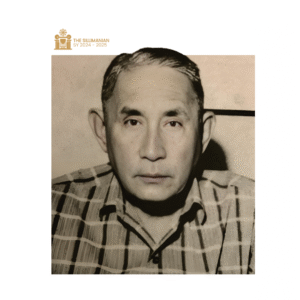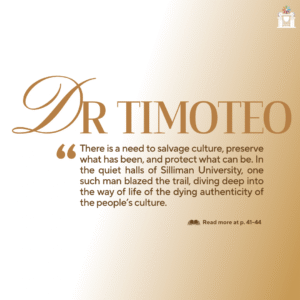

Words by: Lealina Evangeline Reyes
Negros Oriental’s First Anthropologist and the Accounts of a Bygone Culture
There is a need to salvage culture, preserve what has been, and protect what can be. In the quiet halls of Silliman University, one such man blazed the trail, diving deep into the way of life of the dying authenticity of a people’s culture.
Dr. Timoteo Oracion, the first anthropologist of Negros Oriental, lit the torch of knowledge on the study of indigenous people (IP)—particularly the Negritos—and cemented his name to a long-standing legacy.
Working as a captain for United States Army Forces in the Far East during World War II, Oracion’s operations in the mountains of Negros bloomed encounters and interactions with the Negritos and other IP groups like the Bukidnons. Following the war, he became deeply interested in anthropology, which led him to immerse in IP studies.
In his article titled, “Notes on the Culture of Negritos on Negros Island,” Oracion wrote that American anthropologist Fr. John Cooper emphasized the need to collect data on the Negritos. With only a few published materials about them, it was a race against changing times to salvage what was left of the culture.
The urgency of documentation prompted Oracion to revisit the areas where he encountered the Negritos. There, he attempted to describe important aspects of the community’s culture before they are buried underground.
The dark-skinned, curly-haired Negritos who have dwelled in the island far longer than you and I. These indigenous people arrived in Negros Island thousands of years ago.
Locally called Ata, they are remnants of pygmies who lived in the mountains west of Bais City, Negros Oriental. Their physical characteristics are what led to their name, as Spanish explorers initially thought they were “small Negros.” Thus, the name Negrito, which later became the namesake of Negros Island.
The Negritos resided along the coast of the island but the arrival of other groups of people pushed them inland. The once coastal people became residents of inaccessible parts of the mountains. The more people arrived, the farther the native children had to retreat.
Frequent contact with outsiders like the Cebuanos affected their practices, social systems, and even their physical appearance. These alterations left indelible marks on the community and caused their culture to become a dying one.
Oracion’s urgent documenting of what was left in the Negrito culture pioneered a new age for anthropology and IP studies in Negros. Before his contributions to the field, write-ups about IP groups were headed primarily by non-Filipino researchers who have not engaged in prolonged ethnographic studies.
Over time, his study has formed into a framework, carving a path for the next generation of anthropologists to follow. In the pursuit of material on these cultures, various papers were written by his successors, leaving a mark on the lives of these indigenous people.
One such benefit that the IP community received through Oracion’s pioneering work is the cultural basis to claim ancestral domains. This was made possible through the study of Rolando Mascuñana, a student of Oracion who conducted a study titled, “Anthro-Historical Notes on the Indigenous Peoples of Negros Oriental: Recent Findings.”
The works of Oracion served as the baseline for IP recognition in the province, creating a space for recognition, protection, and preservation of their cultures. It is a legacy that highlights the importance of creating a space for the indigenous people, the native children whose roots are deeply embedded in the motherland’s soil.
There is a need to salvage culture, preserve what has been, and protect what can be. Through Oracion’s trailblazing, a path was forged for IP groups to prosper, unearthing a trail of knowledge that continues to be a source of light for the inheritors of his legacy.
